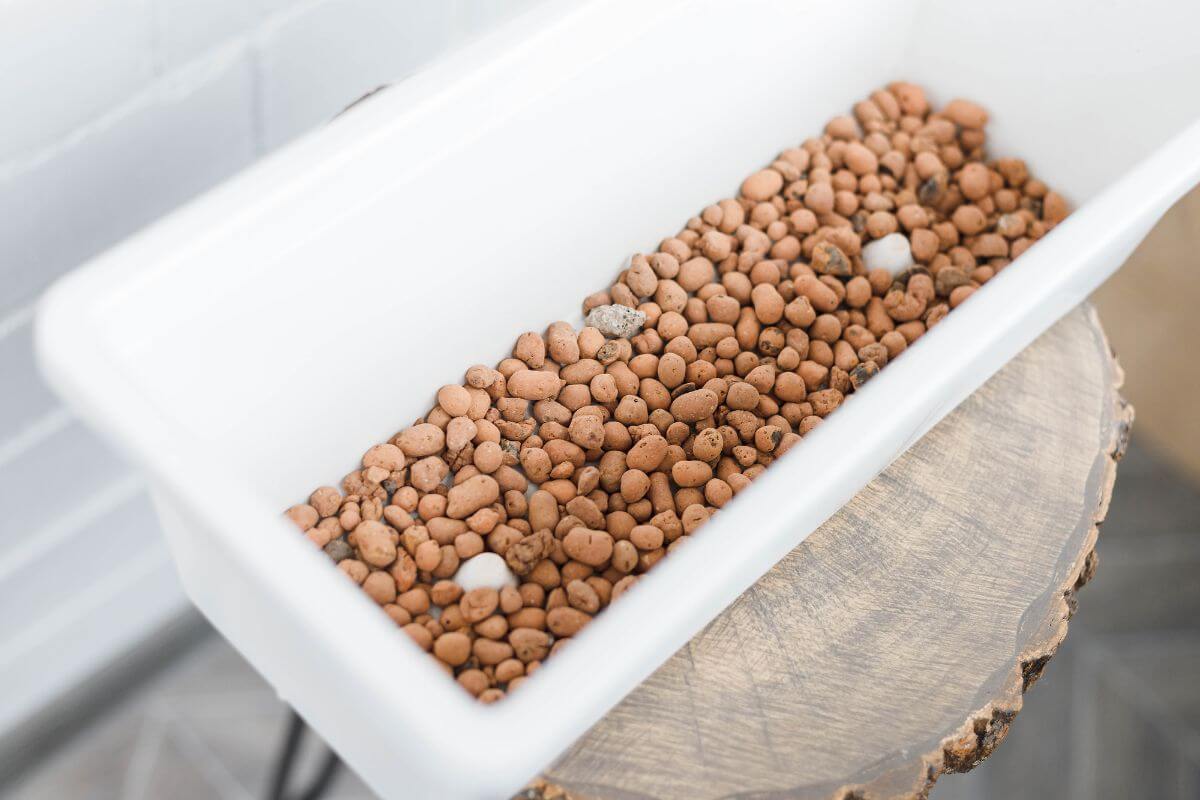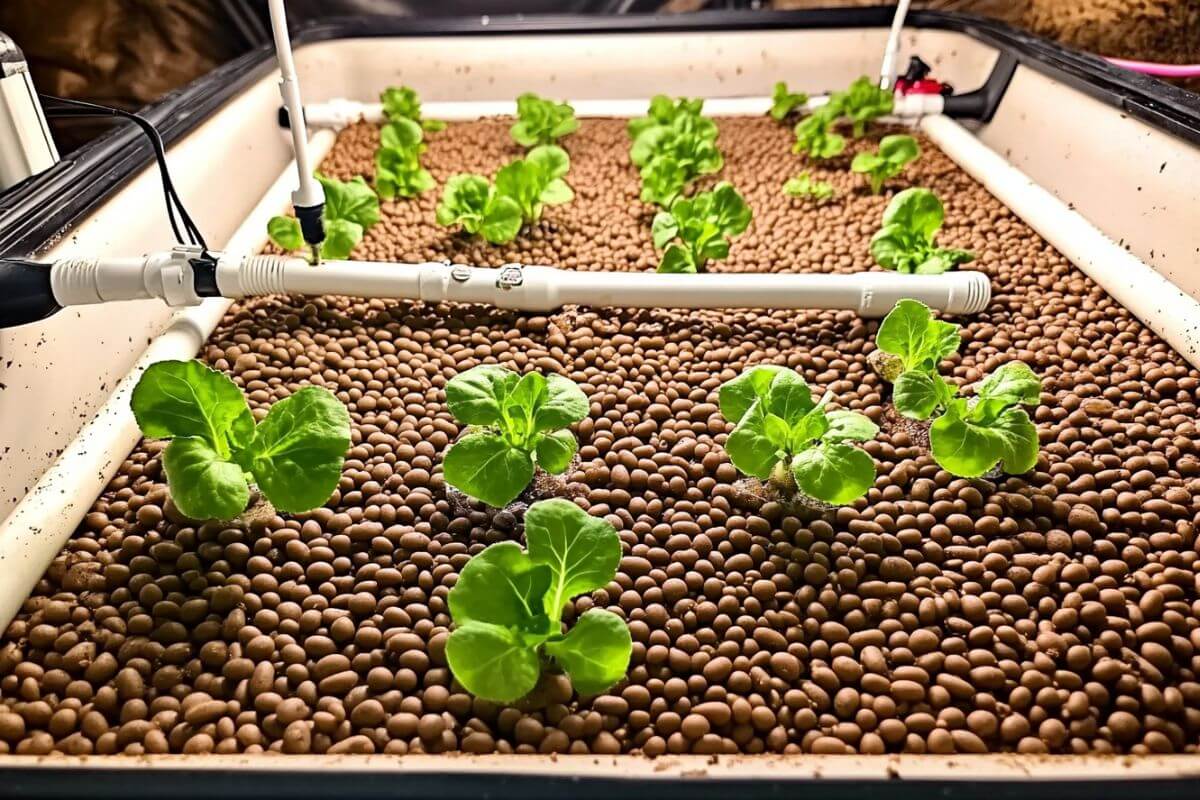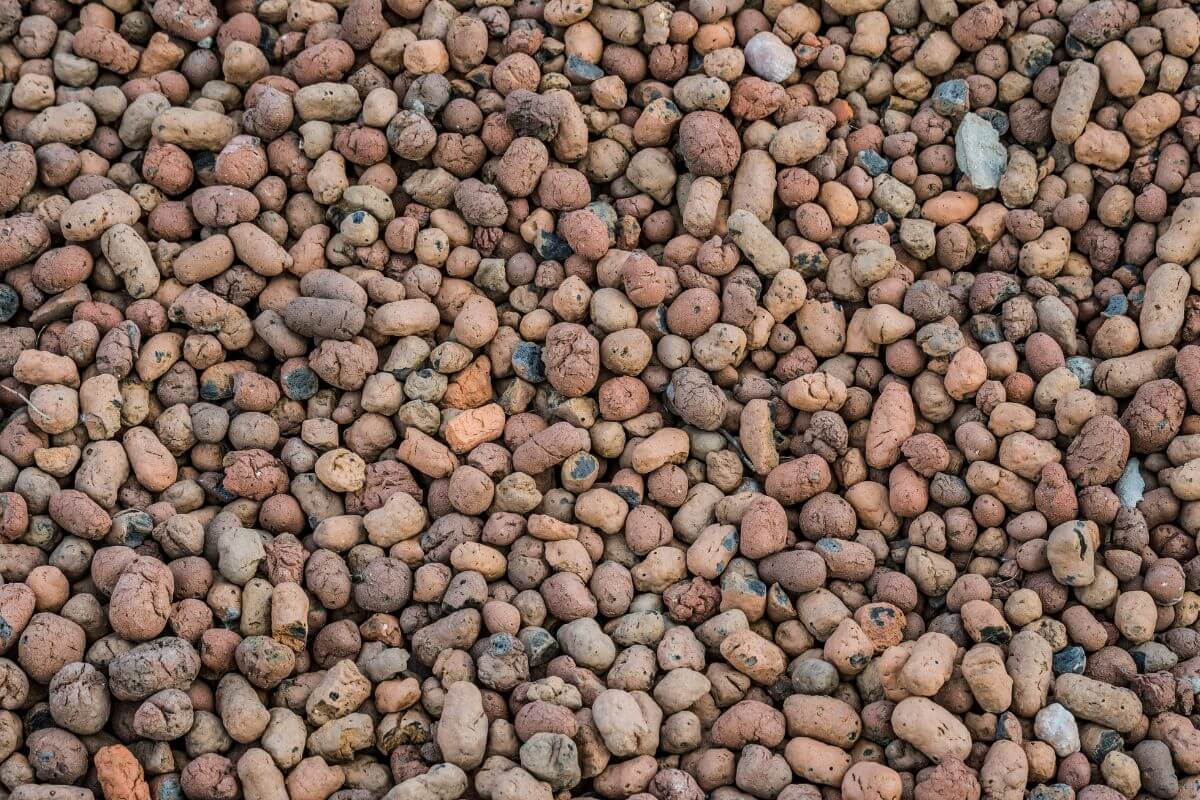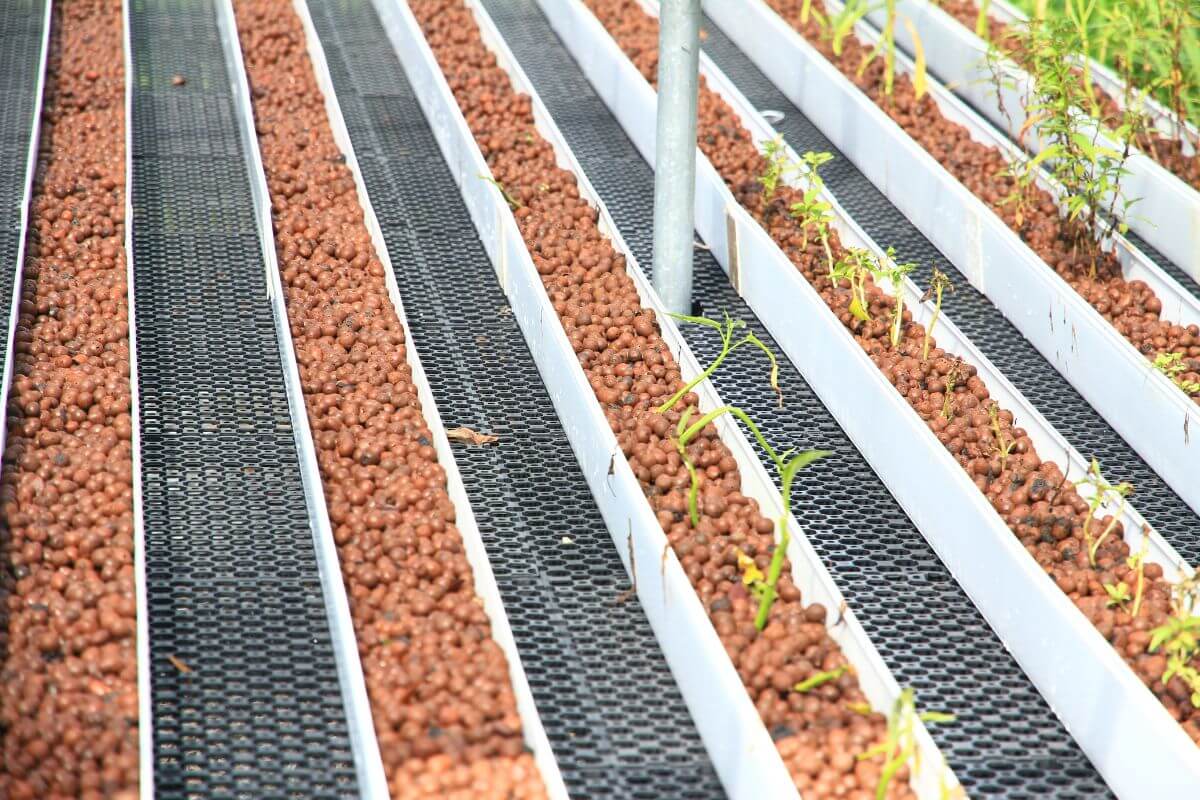Hydroponics is a modern gardening technique that is gaining popularity as a preferred way to grow plants.
Growing plants can be done in small spaces and allows for year-round variety.
Hydroponic systems do not involve soil and instead use various growing mediums to promote healthier plant growth.
One of the most common and favorite substrates used is hydroponic Clay Pebbles because of its Cation exchange capacity, water-holding capacity, and air-filled porosity.
Clay Pebbles, or Clay Pellets, are used in multiple aquaponic systems, the most common being the Ebb and Flow System and the Deep Water Culture system.
- Related article: Hydroponic Growing Mediums
If Clay Pebbles are new to you, don’t worry—we’ll take you through a guide on what exactly these round balls are, the benefits and disadvantages of using them, and some useful tips on how to use them in a hydroponic system!
What are Clay Pebbles?

Clay Pebbles, also referred to as Expanded Clay Aggregate (ECA) and Light Expanded Clay Aggregate (LECA), are simply tiny natural clay balls that have undergone an intense heating process.
The heating process that these clay balls undertake causes them to expand and become porous, creating small air pockets throughout the Clay Pebbles.
Clay Pebbles are available in various shapes and sizes, with the most frequently used ones being similar in proportion to a grape in hydroponic settings.
Benefits of Clay Pebbles as a Growing Medium

Various growing mediums are available for use in hydroponic systems, each offering unique advantages.
Clay Pebbles provide various benefits to a hydroponic system, some of which are:
1. Retains Moisture
The porous holes in Clay Pebbles absorb water as it flows through your hydroponic system, thus these pebbles are able to retain excess moisture for a few days.
These Clay Pebbles not only absorb sufficient moisture, but they’ll also absorb the proper nutrients in your water solution.
2. Adequate Drainage
Effective drainage is crucial for successful hydroponic systems and can be a common obstacle for growers.
Potted plant roots may experience difficulty breathing if they are consistently submerged in excess water, resulting in potential root rot.
The porous Clay Pebbles are able to absorb moisture and offer excellent drainage of water from the roots of your plants.
3. Excellent Root Aeration Properties
The roots of a plant need oxygen to breathe. If they are deprived of oxygen, the plants will begin to focus all their energy on breathing.
This will limit the growth of your plants and possibly lead to them suffocating.
Clay Pebbles are individual clay balls that form a compact growing medium. The spaces that occur between these balls provide excellent aeration for the roots of a plant.
These pebbles are light in weight and the pores in the pebbles trap in air pockets that aid aeration and offer an additional source of oxygen to the roots.
4. Reusable
Clay is a durable natural material that has the tendency to last longer than any other growing medium.
The Clay Pebbles can be reused, and there is no need to replace them after a harvest. You’ll be able to purchase one packet of Clay Pebbles and use it over again.
Using Clay Pebbles will save you money in the long run, and it’s environmentally-friendly to reuse products. All you will need to do is rinse the clay balls off using hot water after a harvest, and allow them to dry.
Unfortunately, Clay Pebbles don’t last forever and will need to be replaced when there is a build-up of salt on the surface, or if you start to notice any organic build-up.
It’s best to replace these clay balls and buy a new pack.
5. Easy to Transplant
Transplanting or removing plants from your hydroponic system without damaging their roots can be rather tricky.
Clay Pebbles are a loose growing medium and provide some freedom when it comes to removing a plant.
The loose clay balls will fall off of a plant’s roots without damaging them, but there may be one or two Clay Pebbles that remain wedged between the roots.
Disadvantages of Clay Pebbles as a Growing Medium

Any growing medium will come with its own set of disadvantages.
Here are some of the disadvantages accompanied by using Clay Pebbles in a hydroponic system:
1. Water Drains Very Quickly
Clay Pebbles are able to hold fresh water in their pores, however, water will still drain very quickly from your growing containers.
The benefit of adequate drainage comes with the cost of less water retention.
Hydroponic systems that use Clay Pebbles need to be checked on frequently and have a dedicated water source constantly.
Your plants will dry up and die should you forget to water your plants on a regular basis.
2. Cause a Blockage
The water pumps in a hydroponic system can, from time to time, get clogged up from clay dust, debris, or floating matter.
Clay Pebbles have been known to cause blockages in water pumps. Due to the lightness of these balls, they tend to float.
Only once a Clay Pebble is saturated with consistent water, it will gain some weight and begin to sink.
If you regularly maintain your hydroponic system, Clay Pebbles shouldn’t cause a blockage as they can be easily removed.
In addition, before using Clay Pebbles, they should be thoroughly rinsed from excessive dust. This excessive dust may cause the drippers or filters in your hydroponic system to clog up.
3. Expensive Growing Medium
Depending on the size of your hydroponic garden, you may be required to purchase several packs of Clay Pebbles.
These pebbles aren’t the cheapest growing mediums available and have quite an expensive market price.
Its retail price or the initial cost of purchasing clay pebbles will eventually pay off, as they can be reused several times. In the long run, you will begin to save money.
Tips for Using Clay Pebbles in Hydroponics

Before incorporating Clay Pebbles into your hydroponic setup, it is crucial to adhere to essential guidelines and methods.
The following are some helpful suggestions for the proper use of Clay Pebbles in a hydroponic system:
1. Rinse and Soak Before Use
It’s always a good idea to rinse off any dust or debris particles first that may have accumulated during the manufacturing process of the Clay Pebbles with clean water.
Dust and debris will eventually cause a blockage in your hydroponic system.
Soaking Clay Pebbles for 6-24 hours in a container with an air stone will allow the water to fully saturate the Clay Pebbles’ pores.
All the dust and debris will then be removed from the Clay Pebbles and they will be safe to use in your hydroponic system.
2. Rinse Your Pebbles Regularly
Unlike soil, Clay Pebbles are an inert medium because they don’t provide any nutrients to your plants.
Clay Pebbles have the ability to bind with and hold added nutrients. As a result of this, they will begin to form a salt residue.
The salt residue that forms on the tops of your Clay Pebbles will cause phytotoxic, which will begin to starve your plants of nutrients and water.
To prevent occurrence, remove Clay Pebbles from the hydroponic system and rinse them using pH-balanced water if plant pots are being used.
Regularly flushing a hydroponic system with pH-balanced water can prevent toxic build-up.
Additionally, using a plant enzyme additive will remove any toxic salt buildup in your system.
3. Add Nutrients Before Use
Once you have thoroughly rinsed your Clay Pebbles, place them in a container with nutrient solution.
Your nutrient solution must have an EC of no greater than 0.4 and this can be measured with an EC meter.
If you don’t have an EC meter, you can just use a quarter (¼) of your base feed. Adding nutrients to your Clay Pebble will prep them for your plants and allow them to soak up nutrients from the start.
4. Begin With Clay Pebbles
When starting off a hydroponic system, many people will begin to germinate their seeds in Rockwool, and then transfer them to Clay Pebbles as they grow bigger.
You can avoid this process and just use Clay Pebbles from the start.
You will need to use small net pods and fill them with a couple of pebbles that have been pre-soaked.
Place your seeds on top of the Clay Pebbles and continue to cover them with several loose pebbles.
The net pods will then have to be placed in a propagator with a mister connected to a timer.
The mister must be set to disperse mist every two to three hours. The constant mist and pre-soaked pebbles will create a humid environment that ensures your seeds begin to germinate.
A simpler way to germinate the seeds, if you don’t have a mister or timer, is to spray water over the net pods daily until the seeds begin to germinate.
Final Thoughts on Clay Pebbles Hydroponic Growing Medium
Hydroponic Clay Pebbles are an exceptional choice for any indoor or outdoor gardening enthusiast.
Not only do these pebbles provide maximum water and nutrient retention for plants, but they also promote aeration and prevent root rot.
With their lightweight and durable nature, hydroponic Clay Pebbles have proved useful in hydroponic setups and traditional gardening methods.
So if you want your plants to thrive and flourish, consider using Clay Pebbles as a hydroponic substrate!
Check out these other articles to learn more about hydroponic grow media:



will clay pebbles work in IBC wicking bed
Hi Debbie! I asked an expert friend of mine who has more experience with IBC wicking bed and he say: Yes, clay pebbles can still work in an IBC wicking bed. You will get the aeration and water retention.